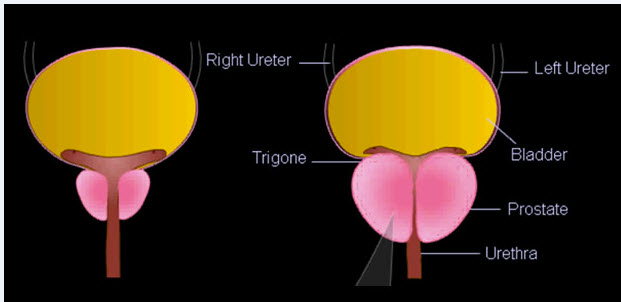What is Benign Prostate Hyperplasia, BPH, for short? BPH is an increase in the number of cells in the prostate, a noncancerous enlarged prostate. BPH is primarily an age related disorder in men which means that by the time BPH symptoms occur, symptoms from other organs and systems of the body have already started to affect them after the age of 50. While BPH is not cancer, it can still damage the bladder and the kidneys to the point where they will no longer function normally. Out of ten men, eight will have an enlarged prostate or suffer from BPH. Men suffer in silence because they feel ashamed to discuss their deteriorating prostate health with others.
“Prostate plays a very important role in men’s health. If your prostate health collapses, so does your reproduction system. BPH is one of the most common prostate problems among men. It is estimated that more than 50% of men over 60 and 80% over 80 years of age suffer the symptoms of BPH. This risk increases with age, but it is not exclusively an old man’s disease.” confirms Dr. Edward Gheiler, co-founder of Urology Specialists in Miami. “Of all men diagnosed, approximately 35% of those are diagnosed at a younger age, and with the lower age factor in mind, sexual function worries increase”. - Affirms Dr. Gheiler.
What are BPH complications?
BPH symptoms may also be caused by other health disorders such as: cardiovascular disorders, (ex: high blood pressure), diabetes, disorders from the nervous system, a weaker immune system, surgical procedures, limited mobility, diminished mental capacity, and other age related problems. BPH complications can arise from lifestyle choices such as smoking, excessive alcohol, sedentary lifestyle, and not having regular medical checkups. Statistically other age related diseases could manifest simultaneously, causing complications that will reduce treatment options for BPH.
BPH Symptoms
Most BPH symptoms mimic bladder symptoms or urinary symptoms. The primary symptoms are a slower stream of urine, frequent urination, urinary retention, difficulty starting urination and trouble stopping urination. Having a urologist diagnose your frequent urination and getting up at night to urinate, is critical because frequent urination, urinary retention, and not being able to urinate, may also be caused by damage to the bladder or kidneys. The reason these prostate symptoms occur is because just below the bladder, the urethra is surrounded by the prostate, and as the prostate enlarges throughout the years, it squeezes and narrows the urethra, making it harder to urinate. As the prostate becomes enlarged, it may also increase the “prostate specific antigen” output, which shows a high PSA number (over 4). The internal effects of BPH occur invisibly over decades without diagnostic tests being performed. As this condition progresses the bladder squeezes harder to empty itself and with each passing year more residual urine is left behind in the bladder. This residual urine slowly damages the bladder as it distends and stretches it. With urine always in the bladder, urinary infections and bladder diverticula can manifest. A weak stream can also be caused by inflammation of the bladder (cystitis), urethra (urethritis), and prostate (prostatitis).
BPH Diagnosis
A urologist will help diagnose your symptoms with your medical history, family history, urine specimen, blood test for PSA, digital rectal exam (DRE), simple voiding flow study that measures the rate at which the urine stream flows, and a post void ultrasound (bladder scan) to determine how much residual urine is left in the bladder after urinating. These simple tests will also help to rule out that the problems are due to the bladder, nervous system, prostate cancer, prostatitis, or urinary tract infection. In order to determine the size of the prostate a flexible cystoscopy can be performed in the office. The flexible cystoscope is a thin optical instrument that slides up the uretha through the prostatic urethra and into the bladder. By doing this how tightly the urethra is being squeezed by the enlarged prostate can be seen. The length of the prostate can also be measured by looking at the scope that travels through the prostatic urethra with a transrectal prostate ultrasound imaging to measure the height, width, length, along with the volume of the prostate.
BPH Treatments These are based on preventative, acute, chronic, or multiple organ complications and treatment option depends on severity of condition.
• Natural alternative medicine
• Prescription medications that relax the bladder neck and shrink the prostate, known as alpha blockers or 5-alpha reductase inhibitors
• Minimally invasive in-office procedures to reduce prostate tissue blockage
- Transurethral microwave therapy or TUMT is performed with a special catheter that is inserted through your urethra resting against your prostate. Microwave energy is then released to generate heat and destroy the blocking enlarged prostate tissue. Over the next few weeks your body breaks down these tissues opening up the urethra and allowing the bladder to empty completely.
- Transurethral needle ablation or TUNA a type of radiofrequency ablation therapy that places a thin scope called a cystoscope into your urethra to place needles into your prostate gland. Radio waves pass through the needles to heat and destroy obstructive prostate tissue. - Da Vinci prostatectomy or “robotic da Vinci surgery” is a cutting edge procedure performed making several tiny slits in the abdomen. It is carried out with laparoscopic surgical instruments that have the advantage of making only several small holes in the stomach area, instead of the traditional long slit through the abdomen, which creates a large scar. This surgery also has the advantage of a faster healing and recovery time, which allows the patient a shorter hospital stay. The da Vinci prostatectomy removes the entire prostate and may include the removal of several other organs near the prostate, however, during this minimally invasive prostatectomy procedure the nerve bundles that are adjacent to the prostate are not damaged, this nerve sparing technique helps the patient maintain their bladder function to hold their urine without complications. This nerve sparing technique also helps maintain sexual function.
• Transurethral resection of the prostate or TURP, the most traditional of procedures, is performed under anesthesia in the operating room with the urologic surgeon placing a cystoscope into the urethra and sliding a tiny loop of wire against the enlarged prostate tissue. By pressing a foot pedal electricity heats up the wire and the surgeon scrapes it along the prostate and removes sliver after sliver of the prostate that is blocking the urethra.
• BPH Surgery, the most common prostate surgery that removes the obstructing prostate tissue in the operating room under anesthesia. The advantages of this are that the patient does not feel pain during procedure, a lot more BPH tissue is removed and the patient is able to leave the hospital the same day with a quick recovery time.











